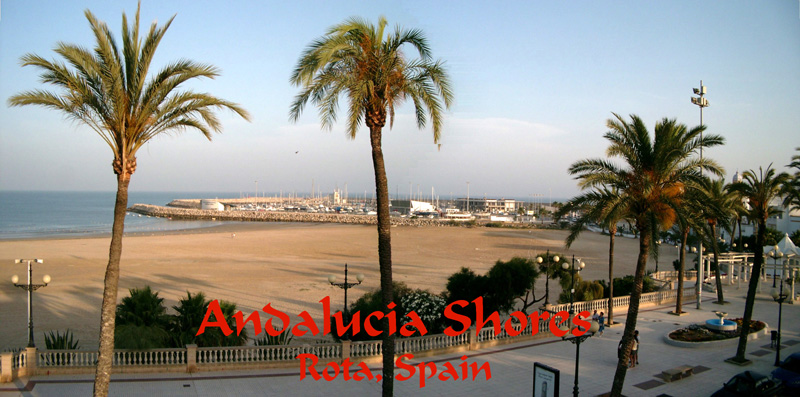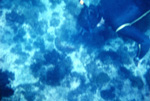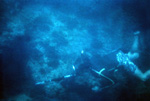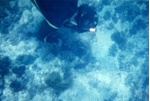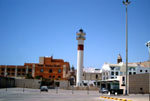|
Diving Spain
Spain is
renowned for its exotic enchantments and beauty. From it's socio-geographical
history to its splendid art treasures, Spain is a place of wonder
and awe. My experiences in Spain started with Rota, near the
southern tip of the country in the province of Cadiz.
My first scuba certification
was from Merchant Marine Academy of Spain. At the time Spain
wouldn't recognized certifications issued outside of its borders.
Also, I didn't have any other scuba certification anyway. The
effort was complicated and took many weeks but when achieved
it proved to be a worthwhile task.
Another
challenge to diving in Spain was that once certified in Spain,
in order to dive you were required to have written authorization
of the regional maritime commander on each occasion and you also
were required to dive with a state chartered diving organization.
On my most recent visit to Rota during the summer of 2005, I
found out that little has changed in this regard but 35 years
later my original dive group buddies were still in Rota and diving.
|
In 1970, nine young men, including
myself, created the original dive club in Rota that we named
"Club Urta". Our main purpose was to enjoy diving and
spearfishing. Don't remember each name of the charter divers.
I'm standing at far left. My prime buddy is Prudente Arjona,
kneeling second from left. Since then the club has grown into
a full-fledged yacht club which encompasses sailing, boating,
fishing, hunting, and diving.
|
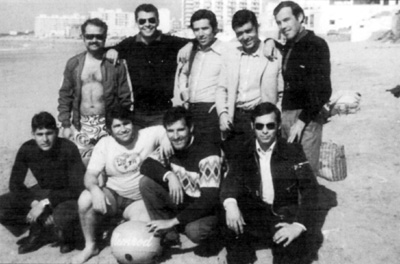 |
Visibility in
the immediate Rota vicinity was never good and most often terrible.
As a consequence we usually found sites not far away in the direction
of Gibraltar that offered some visibility and good fishing. There
were several including Conil, Blanca Paloma, San Roque, and others.
Perhaps the most attractive for us was Conil because of its beautiful
blue water and superb visibility. But it did have its treacheries
with bad currents and rip tides. Nonetheless, we found the abundance
of tasty sea urchins on the shoals quite worthwhile. The trick
was to bring wine and bread along. Then, pick a bag of sea urchins.
On the beach we'd crack open the mushroom shaped shells and eat
the bright orange roe with the dive knife, chasing the morsel
with wine and hearty bread. And oh, what a lovely feast that
was!
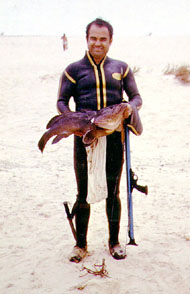 |
My most prized catch was this 20-lb. grouper. I call
it an "accidental" catch because I had given up hope
of even seeing a fish in those crystal clear waters off Blanca
Paloma Beach. There was absolutely nothing on the bottom except
pure white sand, not a preferred place for groupers as it offers
no shadows or shade. I'd even left my speargun on the beach but
my buddy had both his speargun and camera in the water. At one
point he wanted to take pictures and asked me to carry the speargun.
Looking down in about 12 feet I saw this incredible fish resting
on the bottom with his eyes covered by a bit of alga. I load
the spear, took a deep breath and went down hoping he wouldn't
see me too soon. As it turned out he never saw me at all and
I was able to get quite close.
There was no struggle. However, there was exquisite fish eating
in my house for a week or so. I caught other nice fish but never
again one like this.
|
|
A most fascinating semi-submerged archaeological site was
this military fort that extended out on a stone jetty into the
gulf at San Roque, about 50 miles east of Rota and not far from
Gibraltar. The waters here are also crystal clear and a splendid
blue. There were many old and perhaps ancient ship carcasses
and remains around the foundations of this structure. The area
is treacherous because of its strong crosswinds. Many vessels
found themselves dashed upon the shoals that surround the old
fortress.
But even on a windy day and choppy surface, the water always
seemed to offer great visibility. Since this was still Spanish
military property scuba diving was prohibited. Now it's an underwater
park.
|
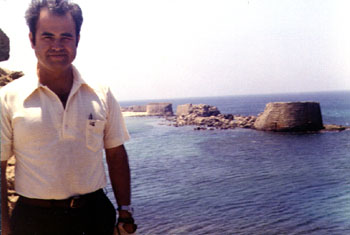 |
|
